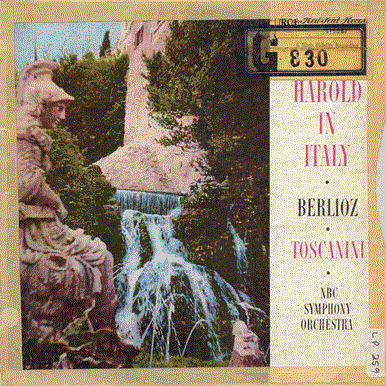| |
After the premiere of Berlioz'
symphony Harold in Italy, an article appeared in a Paris musical
paper which overwhelmed him with invectives, beginning in this witty
style: "Ha, ha, ha! haro! Haro! Harold!" On the morning after the
appearance of this article Berlioz received an anonymous letter in
which, after a deluge of even coarser insults, he was reproached
with not being brave enough to blow out his brains.
'This then was the first reception of Harold in Italy, which had
begun neither as a symphony, nor under that title. It all had
started when Paganini asked Berlioz to write a concerto for viola
and orchestra for him in which he might play his recently •acquired
Stradivarius. Hearing about this, the Gazette, a newly founded
musical periodical, promptly utilized the publicity and announced a
new work by Hector Berlioz for viola, chorus and orchestra, with the
promising title, The Last Moments of Mary Stuart, her story then
being very much in vogue.
Within the next six months Berlioz finished the work —not a
concerto, not for voices, and never again called "Mary Stuart" The
turn of events had been prompted by Paganini himself, who, after
having seen the first draft of the score, had exclaimed: "That is
not at all what I want. I am silent a great deal too long. I must be
playing the whole time." Whereupon Berlioz had replied that since
Paganini really wanted a concerto for the viola, he should write it
himself.
And having thus rid himself of the confining demands of the
illustrious virtuoso, Berlioz proceeded to compose the work
according to his own ideas. He recorded its development and first
performance in his Memoirs published one year after his death. The
following excerpts are reprinted from Memoirs of
Hector Berlioz, edited by Ernest Newman, by permission of the
publisher. Copyright 1932, by Alfred A. Knopf Incorporated.
FINDING THAT THE PLAN Of my composition did not suit him [Paganini],
I applied myself to carrying it out in another way, and without
troubling myself any further as to how the solo part should be
brought into brilliant relief. I conceived the idea of writing a
series of scenes for the orchestra, in which the viola should find
itself mixed up, like a , person more or less in action, always
preserving his own individuality. The background I formed from my
recollections of my wanderings in the Abruzzi, introducing the viola
as a sort of melancholy dreamer, in the style of Byron's Childe
Harold. Hence the title of the symphony, Harold in Italy. As in the
Symphonie Jantastique, one principal theme (the first strain of the
viola) is reproduced throughout the work, but with this difference,
that in the Symphonie fantastique the theme—the idée fixe —obtrudes
itself obstinately, like a passionately episodic figure, into scenes
wholly foreign to it, whilst Harold's strain is super-added to the
other orchestral strains, with which it contrasts both in movement
and character, without hindering their development.
Notwithstanding its complicated harmonic tissue, I took as little
time to compose this symphony as I usually did to write my other
works, though I employed considerable labour in retouching it. In
the Pilgrims' March, which I improvised in a couple of hours one
evening over my fire, I have for more than six years past been
modifying the details, and think that I have much improved it. Even
in its first form it was always completely successful from the
moment of its first performance at my concert in the Conservatoire,
on November 23rd, 1834.
The first movement alone was feebly applauded, but this was the
fault of Girard, who conducted the orchestra, and could not succeed
in working it up enough in the coda, where the pace ought gradually
to be doubled. Without this progressive animation the end of the
allegro is cold and languid. I suffered simple martyrdom in hearing
it thus dragged. The Pilgrims' March was encored. At its second
performance, and towards the middle of the second part—at the place
where the convent-bells . . , are heard afresh after a brief
interruption—at this point the harpist miscounted his bars, and lost
his place. Girard, instead of setting him right, as I have done a
dozen times in tlié same circumstances ... called out, "The last
chord," which the band accordingly gave, thus skipping some fifty
bars. This was a complete slaughter. Fortunately, however, the march
had been well played the first time, and the public were under no
misapprehension about the cause of the disaster at the encore. Had
it happened at first, they would have been sure to attribute the
cacophony to the composer. Still, since my defeat at the
Théàtre-Italien [in the middle of a concert given on November 24,
1833, Berlioz found himself deserted by most of the orchestra
members], I had such mistrust of my own skill as a conductor that I
allowed Girard to direct my concerts for some time longer; but at
the fourth performance of Harold he made so serious a mistake at the
end of the serenade (where, if one part of the orchestra does not
double its speed, the other part cannot go on, because the whole bar
of the former corresponds to the half bar of the latter) that,
seeing at last that there was no hope of his working up the end of
the. allegro properly, I resolved in future to conduct myself, and
not allow anyone else to communicate my ideas to the performers.
© 1956, Radio Corporation of America
MANUFACTURED IN AUSTRALIA - PRODUCT OF RCA OF AUSTRALIA PTY. LTD.
RECORDED BY RADIO CORPORATION OF AMERICA.
USE OF MASTER RECORDING AND TRADEMARK AUTHORIZED BY RADIO
CORPORATION OF AMERICA. 16087 |
|
|
|





